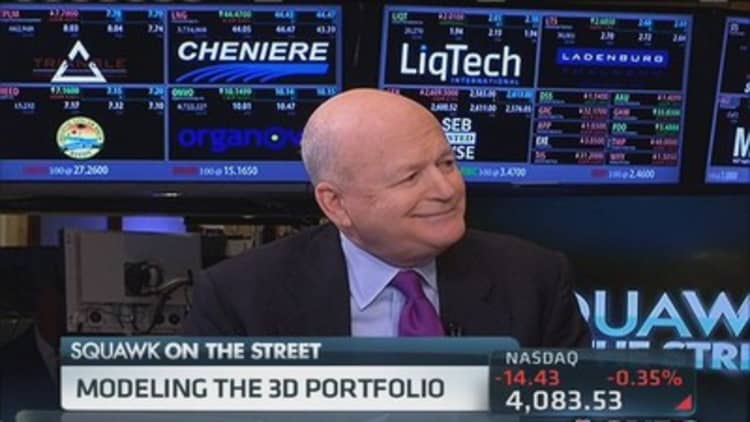The upward run of 3-D-printing stocks can largely be attributed to hype rather than to an imminent revolution in consumer technology, according to analysts.
(Read more: What investors need to know about 3-D printing)
"The 3-D-printing industry isn't revolutionary, it's evolutionary," said Andrew Left, a notable short seller and chief of Citron Research. "In a hot market like this, you get a good story. It just captures peoples' imaginations, but in this case it also captures peoples' dollars."
While the technology has been around for more than 30 years, the industry has received an enormous amount of attention with the recent availability of consumer printers—a shift that has helped drive up stock prices, according to industry experts.
For example, 3D Systems' stock price has risen more than 120 percent during the past 12 months. Stratasys shares have jumped more than 98 percent, while those of Voxeljet and ExOne also have got significant boosts.
But investors should beware, as not all 3-D-printing companies are created equal, said Phil Reeves, managing director of Econolyst, a consulting and research firm.
"When you look at these stocks, they all appear to be intrinsically linked," he said at the 3-D Printshow in New York earlier this month. "When one goes up, the others go up, and when one goes down, the others go down."
(Read more: )
But, he added, "when you map out their business models, some of them have nothing to do with each other as businesses. And they have very different business dynamics and different customer bases."
3D Systems, for instance, has one of the category's most robust portfolios, including rapid prototyping, manufacturing and 3-D-printing solutions. But it also has shortcomings, according to analysts.
(Read more: How this $99 3-D-printed drone could change the toy industry )
Though the company has made more than 40 acquisitions in the past three years, it has struggled to establish an area in which it stands out, Reeves said.
"Companies like 3D Systems are becoming jacks-of-all-trades and masters of none," he said. "They're not actually the market leader in any of the things they are in."
3D Systems declined to comment for this article.
Some smaller players are actually more dominant, Reeves said.
The privately held German company EOS—a market leader in metal printers—far exceeds 3D Systems in technology and industrial sales, he said.
And Voxeljet has pioneered technological advancements in the industrial segment that could negatively affect 3D Systems and EOS' business, Reeves added. (Voxeljet's stock has had a rocky ride but is still up 20 percent since its initial public offering in October.)
He pointed out that Voxeljet depends on patent technology from MIT that expires in three years, which will open the door to more competition.
ExOne, a competitor of Voxeljet, was downgraded by Canaccord Genuity in January to hold from buy. The firm also lowered its price target for the stock to $55 from $75, saying that multiple revisions to ExOne's outlook make it concerned about the company's organic growth.
Neither Voxeljet nor ExOne responded to requests for comment.
Several firms have recently downgraded 3D Systems, which closed at $75.85 on Tuesday. Bank of America-Merrill Lynch bounced the stock all the way to underperform from buy Monday and lowered its price target for the stock to $65 from $90.
BofA analyst Wamsi Mohan cited concerns about the company's organic growth rate, among other reasons, for the move.
Left, who is short the stock, released a report earlier this month calling 3D Sytems' stock a bubble. On the consumer side, the company has failed to sell many of its Cube printers, he said, and it doesn't have the technology to compete on the enterprise side.
"It's going to be a single-digit stock in two to three years," he said. "3D Systems is a joke because it's a roll-up of third- and fourth-generation technology. The reason they are doomed is because they can't roll anything up anymore."
Still room for gradual growth

Even though there's unearned excitement surrounding the 3-D-printing stocks, analysts said there's still opportunity for long-term investors.
Gartner estimates that global shipments of 3-D printers grew by 49 percent last year and expects them to rise by 75 percent in 2014.
While it's expected that more consumer printers than industrial will be shipped, the industry's revenue growth will primarily be driven by sales of high-end printers to enterprise players—the more expensive machines, said Pete Basiliere, a research director at Gartner.
According to Reeves, the industry has discovered only 8 percent of the possible applications for 3-D printing. Growth is simply going to take longer than people expect.
"The more we develop the opportunity, it's like an iceberg—the opportunity we find underneath the water becomes bigger and begins to spread out," he said.
In 2012, 3-D printing was a $100 million market, including the sale of the machines and materials, but it has the potential to be a $15 billion industry by 2020, according to Econolyst research.
Companies with the strong technologies and engines for their devices—including Stratasys, Voxeljet and EOS—will be the midterm winners, Reeves said.
—By CNBC's Cadie Thompson. Follow her on Twitter @CadieThompson.


